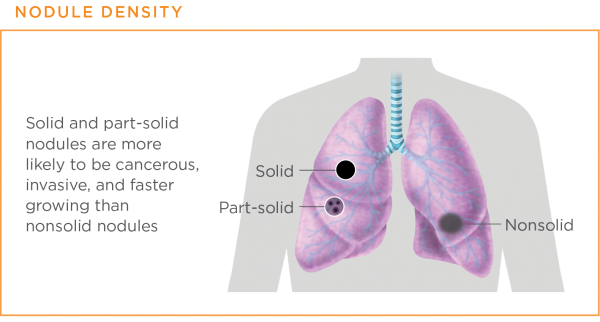The abnormalities that can be detected by the LDCT are known as lung nodules. They may also be referred to as pulmonary nodules. Nodules are tissue growths that appear as round or oval-shaped white shadows. Lung nodules are very common, and most are not cancerous. In fact, only about 4% of nodules detected by screening are cancerous. What happens if one or more nodules are found, and how it is determined whether a nodule is cancerous, are discussed in a later section.1,2
A nodule is characterized by:1
- Size: Nodules are measured in millimeters (mm). Many nodules are very small. For example, they are about the size of a pea (typically about 5 mm)
- Shape: Lung nodules may have smooth surfaces or have uneven surfaces due to the presence of spicules (spikes or points) or lobules (the appearance of several rounded nodules together). Most of the spiculated or lobulated nodules are cancerous

Density: Lung nodules are characterized according to how solid or fuzzy—how dense—they appear in an LDCT image. They are characterized as either solid, nonsolid, or part-solid:
- Solid nodules are the densest and appear similar to the way muscle would appear. Solid nodules are the type most often detected
- Nonsolid nodules look the fuzziest. Because of their appearance, they are also referred to as ground-glass nodules. These are considered to be the least likely to be cancerous
- Part-solid nodules also have a fuzzy look, but they have both solid and nonsolid (ground-glass) areas. Part-solid nodules are considered to be the most likely to be cancerous

What can cause lung nodules to form?
As mentioned earlier, lung nodules are common. There are a number of reasons, in addition to lung cancer, why someone may develop lung nodules. Most lung nodules are, in fact, not cancerous. While lung cancer is one cause of lung nodules, other reasons for lung nodules include:3
- Infections: Bacterial and fungal infections can cause a nodule in the lung, called a granuloma, which is a small cluster of cells that forms after the infection as a result of inflammation. Examples of bacterial infections include mycobacterium (Mycobacterium tuberculosis or Mycobacterium avium-intracellulare). Examples of fungal infections include histoplasmosis and coccidioidomycosis
- Noninfectious causes: Noninfectious illnesses, such as sarcoidosis—which causes granulomas in the lungs and other parts of the body—and rheumatoid arthritis can also cause lung nodules
- Neoplasms: Neoplasms refer to any abnormal growths; they may be either cancerous or noncancerous. The most common type of benign neoplasm is a hamartoma
Updated March 9, 2021
References
- NCCN Guidelines for Patients®: Lung Cancer Screening, Version 1.2020. The National Comprehensive Cancer Network® website. https://NCCN.org/patients/guidelines/lung_screening/files/assets/common/downloads/files/lungscreening.pdf. Posted May 14, 2019. Accessed November 2020.
- McWilliams A, Tammemagi MC, Mayo JR, et al. Probability of cancer in pulmonary nodules detected on first screening CT. N Engl J Med. 2013;369(10):910-919. Accessed August 10, 2020.
- Pulmonary Nodules. Cleveland Clinic website. https://my.clevelandclinic.org/health/diseases/14799-pulmonary-nodules. Published 2016. Accessed July 15, 2020.
